Accommodation · Asia · Featured · Food and Drink · Going Out · Hotels · India · Regions · Resorts · Restaurants · Travel Miscellany
Special feature: Aman-i-Khas, Ranthambore, Rajasthan, India
Once we had cleared the sprawling madness of the city of Gurgaon, which took an hour and a half, the remainder of the six-hour drive from our hotel to southern Rajasthan was surprisingly pleasant, albeit long, crossing through open expanses of agriculture and the rolling hills of the Aravali Range, along with the occasional quaint village or town where we often enjoyed a breakfast or quick lunch. The final part of the drive cut through the city and Municipal Corporation of Sawai Madhophur, deep within the outskirts of which lies Aman-i-Khas a 10-room tented camp operated by Aman bordering Ranthambore National Park, a former hunting ground of the Maharajas of Jaipur.
 The national park, one of Indias largest and known worldwide for its tiger habitat, has received much attention following the dedicated protection effort taken by authorities to urgently conserve and restore the tiger population after a rapid and alarming decline in numbers for decades as a result of poaching and neglect. Thankfully, the only shooting which now occurs at the park is through the lens of a camera, if you are lucky enough to spot the shy striped specimen.
The national park, one of Indias largest and known worldwide for its tiger habitat, has received much attention following the dedicated protection effort taken by authorities to urgently conserve and restore the tiger population after a rapid and alarming decline in numbers for decades as a result of poaching and neglect. Thankfully, the only shooting which now occurs at the park is through the lens of a camera, if you are lucky enough to spot the shy striped specimen.
 Upon arrival, we were met by the Executive Assistant Amit Dixit, standing in for the General Manager, and introduced to our batman (or butler) Satish, who assisted us throughout the stay. Satish escorted us to our standalone tent, but the term is a bit of a misnomer when it comes to Aman-i-Khas, for it is only a tent in name and its tented exterior structure. The 108 sqm (1,162 sqft) Mughal-inspired tents, designed by famed designer Jean-Michel Gathy, feature a six-metre canopy, bedroom, living area and bathroom separated by cotton drapes, and a sundeck, and furnished and designed in Amans signature elegant minimalist style. The floor, matted in some areas, and the sunken bath are made from stone sourced locally. If all tents were made equal like this, Id probably go camping far more often!
Upon arrival, we were met by the Executive Assistant Amit Dixit, standing in for the General Manager, and introduced to our batman (or butler) Satish, who assisted us throughout the stay. Satish escorted us to our standalone tent, but the term is a bit of a misnomer when it comes to Aman-i-Khas, for it is only a tent in name and its tented exterior structure. The 108 sqm (1,162 sqft) Mughal-inspired tents, designed by famed designer Jean-Michel Gathy, feature a six-metre canopy, bedroom, living area and bathroom separated by cotton drapes, and a sundeck, and furnished and designed in Amans signature elegant minimalist style. The floor, matted in some areas, and the sunken bath are made from stone sourced locally. If all tents were made equal like this, Id probably go camping far more often!
 Aman-i-Khas, derived from the Sanskrit aman, meaning peace, and the Hindi/Urdu word of khas, meaning special or privileged, sits within a rugged and verdant brushwood forest. Aside from the most comfortable camping experience ever thanks to the oversized accommodation that, while feeling luxurious, never veers from the wild outdoors, it is the experience which elevates the place.
Aman-i-Khas, derived from the Sanskrit aman, meaning peace, and the Hindi/Urdu word of khas, meaning special or privileged, sits within a rugged and verdant brushwood forest. Aside from the most comfortable camping experience ever thanks to the oversized accommodation that, while feeling luxurious, never veers from the wild outdoors, it is the experience which elevates the place.
 The camp covers 10 acres, home to several flora and fauna and a lake that is inhabited by two crocodiles. The camping experience is all-inclusive, with meals, laundry and soft drinks from the mini-bar accounted for in the rate, but the special touches the staff and your batman bring are what really add to your stay; for travelers taking the alternative route from Delhi to Sawai Madhopur by train, your batman will accompany you on the train journey from Delhi to the camp. The batmen are available at your call any time, 24 hours a day, and will go out of their way to prepare that special experience for you, and seemingly pop up out of nowhere the minute you leave your tent.
The camp covers 10 acres, home to several flora and fauna and a lake that is inhabited by two crocodiles. The camping experience is all-inclusive, with meals, laundry and soft drinks from the mini-bar accounted for in the rate, but the special touches the staff and your batman bring are what really add to your stay; for travelers taking the alternative route from Delhi to Sawai Madhopur by train, your batman will accompany you on the train journey from Delhi to the camp. The batmen are available at your call any time, 24 hours a day, and will go out of their way to prepare that special experience for you, and seemingly pop up out of nowhere the minute you leave your tent.
 The second morning, we had a trip planned into the national park, and were awoken as requested by the staff at the crack of dawn, who thoughtfully left hot tea, freshly squeezed cold orange juice, and a light snack at the patio of the tent for us to freshen up before heading out to meet at the entrance of the camp, in an open-top jeep. The safari excursion, held twice daily in the morning and afternoon, can be booked privately for your party, or shared with other guests at the resort.
The second morning, we had a trip planned into the national park, and were awoken as requested by the staff at the crack of dawn, who thoughtfully left hot tea, freshly squeezed cold orange juice, and a light snack at the patio of the tent for us to freshen up before heading out to meet at the entrance of the camp, in an open-top jeep. The safari excursion, held twice daily in the morning and afternoon, can be booked privately for your party, or shared with other guests at the resort.
 The excursions are led by guides from Ranthambore National Park, many of whom have worked in the park for decades. The park is split into zones, and the park rangers will control which zone the jeep is allowed into to manage traffic and overcrowding. While the park is most certainly famed for its tigers and leopards, there is a plethora of wildlife native to India here to see beyond the big cats, including the nilgai, sambar, striped hyena, sloth bear, southern plains gray langur, rhesus macaque and chital. Following the monsoon season, the park was very verdant and brimming with green it eventually dries out over the following months which supposedly makes wildlife spotting easier, and is also when wildlife photographers tend to visit the region, and the best times to visit for tiger sightings are reputedly November and May.
The excursions are led by guides from Ranthambore National Park, many of whom have worked in the park for decades. The park is split into zones, and the park rangers will control which zone the jeep is allowed into to manage traffic and overcrowding. While the park is most certainly famed for its tigers and leopards, there is a plethora of wildlife native to India here to see beyond the big cats, including the nilgai, sambar, striped hyena, sloth bear, southern plains gray langur, rhesus macaque and chital. Following the monsoon season, the park was very verdant and brimming with green it eventually dries out over the following months which supposedly makes wildlife spotting easier, and is also when wildlife photographers tend to visit the region, and the best times to visit for tiger sightings are reputedly November and May.
 Sadly, we were not to see a tiger on our visit but its a numbers game, and the more safari excursions you book, the higher your chances of seeing a tiger. We did see a few leopards though, which we understand are typically even harder to spot, as well as nilgai and the rhesus macaque. After much effort to find the elusive big cat, we found a clearing, where in typical Aman style, we were treated to a picnic in the middle of Ranthambore National Park with hot tea and coffee and cakes, before returning to the campsite, where, of course, our batman Satish was waiting for us with a refreshing drink and a cold towel.
Sadly, we were not to see a tiger on our visit but its a numbers game, and the more safari excursions you book, the higher your chances of seeing a tiger. We did see a few leopards though, which we understand are typically even harder to spot, as well as nilgai and the rhesus macaque. After much effort to find the elusive big cat, we found a clearing, where in typical Aman style, we were treated to a picnic in the middle of Ranthambore National Park with hot tea and coffee and cakes, before returning to the campsite, where, of course, our batman Satish was waiting for us with a refreshing drink and a cold towel.
 The afternoon was spent lazing and cooling at the camps swimming pool. Drawing from local architecture, the pool is fashioned after a baori, or stepwell wells or ponds that feature a descending set of steps, and are found throughout Rajasthan. Within a minute of finding myself at the pool, an alert attendant came by to set-up the sun-lounger and offered a selection of refreshing drinks and water. Come dusk, the camp takes on a true camp-like atmosphere, where the stone-enclosed elevated patio near the main section of tents, which house the library, spa, restaurant, lounge and boutique, is turned into a cozy camp-side fire in the cool night, where local musicians enchanted us with their folk songs while we enjoyed pre-dinner drinks.
The afternoon was spent lazing and cooling at the camps swimming pool. Drawing from local architecture, the pool is fashioned after a baori, or stepwell wells or ponds that feature a descending set of steps, and are found throughout Rajasthan. Within a minute of finding myself at the pool, an alert attendant came by to set-up the sun-lounger and offered a selection of refreshing drinks and water. Come dusk, the camp takes on a true camp-like atmosphere, where the stone-enclosed elevated patio near the main section of tents, which house the library, spa, restaurant, lounge and boutique, is turned into a cozy camp-side fire in the cool night, where local musicians enchanted us with their folk songs while we enjoyed pre-dinner drinks.
 While the main set of tents house the restaurant space, guests are also often treated to a special dining experience (set up by the batman) on the outskirts of the camps property, with settings that mix tradition (using earthen tandoors, iron, copper pots and homemade clay ovens,) and modern comforts (tables and seats) in a truly spectacular setting in the midst of the jungle beneath the stars. The camps large herb and vegetable gardens produce most of the stock used for food, and a mix of local Indian fare and Western is available for breakfast, lunch and dinner, including the Rajasthani specialty of laal maas, a tender lamb curry cooked in yoghurt and chillies, that was the highlight of our private dinner.
While the main set of tents house the restaurant space, guests are also often treated to a special dining experience (set up by the batman) on the outskirts of the camps property, with settings that mix tradition (using earthen tandoors, iron, copper pots and homemade clay ovens,) and modern comforts (tables and seats) in a truly spectacular setting in the midst of the jungle beneath the stars. The camps large herb and vegetable gardens produce most of the stock used for food, and a mix of local Indian fare and Western is available for breakfast, lunch and dinner, including the Rajasthani specialty of laal maas, a tender lamb curry cooked in yoghurt and chillies, that was the highlight of our private dinner.
 On our final afternoon, we ventured back to Ranthambore National Park, but this time not for a chance to spot a tiger. Ranthambore Fort, a UNESCO World Heritage Site, sits within the confines of Ranthambore National Park. Although the exact history of the fort is yet to be established (the fort holds many myths and legends), it is known that it was built by a Chauhan Rajput ruler sometime between 944-1110 CE. Our guide led us through the several gates and layers of the fort, relaying the many myths and legends and a bit of history, leaving us to be the judge.
On our final afternoon, we ventured back to Ranthambore National Park, but this time not for a chance to spot a tiger. Ranthambore Fort, a UNESCO World Heritage Site, sits within the confines of Ranthambore National Park. Although the exact history of the fort is yet to be established (the fort holds many myths and legends), it is known that it was built by a Chauhan Rajput ruler sometime between 944-1110 CE. Our guide led us through the several gates and layers of the fort, relaying the many myths and legends and a bit of history, leaving us to be the judge.
 Walking back to the entrance of the fort exhausted from the elevated climbs and looking forward to afternoon tea at the camp, our guide purposely led us astray on one turn, much to our dismay. The astray route led us to dark chambers and narrow stairwells, which we were reluctant to climb, but did so at the insistence of our guide. After huffing and puffing our way to the top of the stairs, it immediately became clear why our guide insisted on the extra effort at a large clearing of the fort with panoramic views over Ranthambore Fort, stood our batman Satish, holding a picnic basket replete with cakes and biscuits and a flask with hot tea, and a cup of warm milk on the side as my partner had once requested on the very first day, a preference well remembered. With Satishs thoughtful surprise and exemplary service, we enjoyed afternoon tea at a timely manner at the fort, with stunning views overlooking Ranthambore.
Walking back to the entrance of the fort exhausted from the elevated climbs and looking forward to afternoon tea at the camp, our guide purposely led us astray on one turn, much to our dismay. The astray route led us to dark chambers and narrow stairwells, which we were reluctant to climb, but did so at the insistence of our guide. After huffing and puffing our way to the top of the stairs, it immediately became clear why our guide insisted on the extra effort at a large clearing of the fort with panoramic views over Ranthambore Fort, stood our batman Satish, holding a picnic basket replete with cakes and biscuits and a flask with hot tea, and a cup of warm milk on the side as my partner had once requested on the very first day, a preference well remembered. With Satishs thoughtful surprise and exemplary service, we enjoyed afternoon tea at a timely manner at the fort, with stunning views overlooking Ranthambore.
 Checking out the next day after a hearty breakfast was difficult, but it was onward to our next Aman in India, Amanbagh. Read our review of Amanbagh here.
For travelers to India looking to extend their stay or experience something beyond Rajasthans series of forts, palaces and fort-/palace-hotels, Amans wildlife tented camp and retreat is the perfect alternative or addition to the traditional Rajasthani itinerary.
Disclosure: Our stay was courtesy of Aman-i-Khas.
Checking out the next day after a hearty breakfast was difficult, but it was onward to our next Aman in India, Amanbagh. Read our review of Amanbagh here.
For travelers to India looking to extend their stay or experience something beyond Rajasthans series of forts, palaces and fort-/palace-hotels, Amans wildlife tented camp and retreat is the perfect alternative or addition to the traditional Rajasthani itinerary.
Disclosure: Our stay was courtesy of Aman-i-Khas.
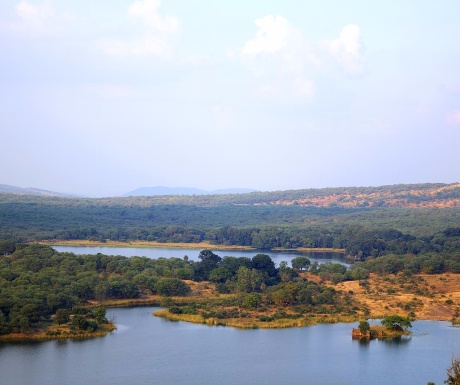 The national park, one of Indias largest and known worldwide for its tiger habitat, has received much attention following the dedicated protection effort taken by authorities to urgently conserve and restore the tiger population after a rapid and alarming decline in numbers for decades as a result of poaching and neglect. Thankfully, the only shooting which now occurs at the park is through the lens of a camera, if you are lucky enough to spot the shy striped specimen.
The national park, one of Indias largest and known worldwide for its tiger habitat, has received much attention following the dedicated protection effort taken by authorities to urgently conserve and restore the tiger population after a rapid and alarming decline in numbers for decades as a result of poaching and neglect. Thankfully, the only shooting which now occurs at the park is through the lens of a camera, if you are lucky enough to spot the shy striped specimen.
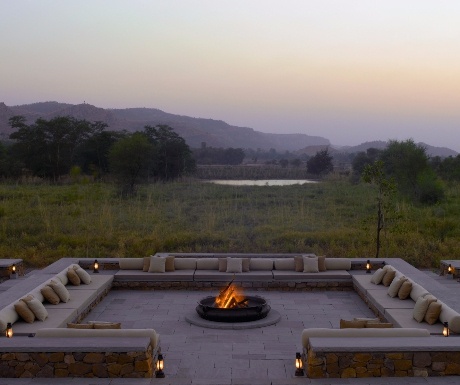 Upon arrival, we were met by the Executive Assistant Amit Dixit, standing in for the General Manager, and introduced to our batman (or butler) Satish, who assisted us throughout the stay. Satish escorted us to our standalone tent, but the term is a bit of a misnomer when it comes to Aman-i-Khas, for it is only a tent in name and its tented exterior structure. The 108 sqm (1,162 sqft) Mughal-inspired tents, designed by famed designer Jean-Michel Gathy, feature a six-metre canopy, bedroom, living area and bathroom separated by cotton drapes, and a sundeck, and furnished and designed in Amans signature elegant minimalist style. The floor, matted in some areas, and the sunken bath are made from stone sourced locally. If all tents were made equal like this, Id probably go camping far more often!
Upon arrival, we were met by the Executive Assistant Amit Dixit, standing in for the General Manager, and introduced to our batman (or butler) Satish, who assisted us throughout the stay. Satish escorted us to our standalone tent, but the term is a bit of a misnomer when it comes to Aman-i-Khas, for it is only a tent in name and its tented exterior structure. The 108 sqm (1,162 sqft) Mughal-inspired tents, designed by famed designer Jean-Michel Gathy, feature a six-metre canopy, bedroom, living area and bathroom separated by cotton drapes, and a sundeck, and furnished and designed in Amans signature elegant minimalist style. The floor, matted in some areas, and the sunken bath are made from stone sourced locally. If all tents were made equal like this, Id probably go camping far more often!
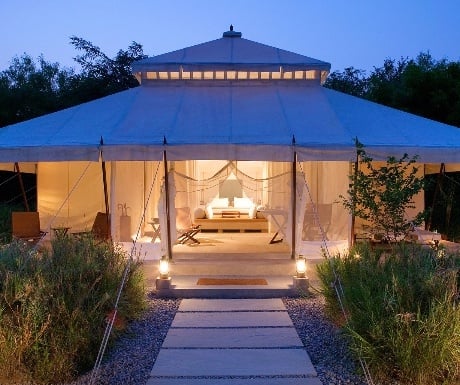 Aman-i-Khas, derived from the Sanskrit aman, meaning peace, and the Hindi/Urdu word of khas, meaning special or privileged, sits within a rugged and verdant brushwood forest. Aside from the most comfortable camping experience ever thanks to the oversized accommodation that, while feeling luxurious, never veers from the wild outdoors, it is the experience which elevates the place.
Aman-i-Khas, derived from the Sanskrit aman, meaning peace, and the Hindi/Urdu word of khas, meaning special or privileged, sits within a rugged and verdant brushwood forest. Aside from the most comfortable camping experience ever thanks to the oversized accommodation that, while feeling luxurious, never veers from the wild outdoors, it is the experience which elevates the place.
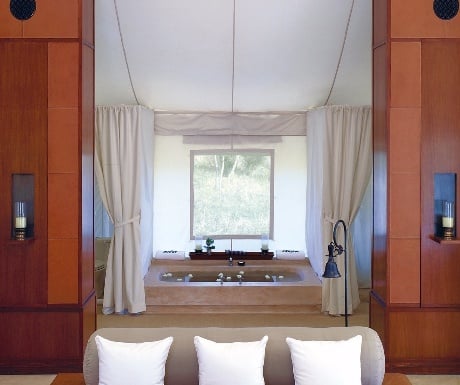 The camp covers 10 acres, home to several flora and fauna and a lake that is inhabited by two crocodiles. The camping experience is all-inclusive, with meals, laundry and soft drinks from the mini-bar accounted for in the rate, but the special touches the staff and your batman bring are what really add to your stay; for travelers taking the alternative route from Delhi to Sawai Madhopur by train, your batman will accompany you on the train journey from Delhi to the camp. The batmen are available at your call any time, 24 hours a day, and will go out of their way to prepare that special experience for you, and seemingly pop up out of nowhere the minute you leave your tent.
The camp covers 10 acres, home to several flora and fauna and a lake that is inhabited by two crocodiles. The camping experience is all-inclusive, with meals, laundry and soft drinks from the mini-bar accounted for in the rate, but the special touches the staff and your batman bring are what really add to your stay; for travelers taking the alternative route from Delhi to Sawai Madhopur by train, your batman will accompany you on the train journey from Delhi to the camp. The batmen are available at your call any time, 24 hours a day, and will go out of their way to prepare that special experience for you, and seemingly pop up out of nowhere the minute you leave your tent.
 The second morning, we had a trip planned into the national park, and were awoken as requested by the staff at the crack of dawn, who thoughtfully left hot tea, freshly squeezed cold orange juice, and a light snack at the patio of the tent for us to freshen up before heading out to meet at the entrance of the camp, in an open-top jeep. The safari excursion, held twice daily in the morning and afternoon, can be booked privately for your party, or shared with other guests at the resort.
The second morning, we had a trip planned into the national park, and were awoken as requested by the staff at the crack of dawn, who thoughtfully left hot tea, freshly squeezed cold orange juice, and a light snack at the patio of the tent for us to freshen up before heading out to meet at the entrance of the camp, in an open-top jeep. The safari excursion, held twice daily in the morning and afternoon, can be booked privately for your party, or shared with other guests at the resort.
 The excursions are led by guides from Ranthambore National Park, many of whom have worked in the park for decades. The park is split into zones, and the park rangers will control which zone the jeep is allowed into to manage traffic and overcrowding. While the park is most certainly famed for its tigers and leopards, there is a plethora of wildlife native to India here to see beyond the big cats, including the nilgai, sambar, striped hyena, sloth bear, southern plains gray langur, rhesus macaque and chital. Following the monsoon season, the park was very verdant and brimming with green it eventually dries out over the following months which supposedly makes wildlife spotting easier, and is also when wildlife photographers tend to visit the region, and the best times to visit for tiger sightings are reputedly November and May.
The excursions are led by guides from Ranthambore National Park, many of whom have worked in the park for decades. The park is split into zones, and the park rangers will control which zone the jeep is allowed into to manage traffic and overcrowding. While the park is most certainly famed for its tigers and leopards, there is a plethora of wildlife native to India here to see beyond the big cats, including the nilgai, sambar, striped hyena, sloth bear, southern plains gray langur, rhesus macaque and chital. Following the monsoon season, the park was very verdant and brimming with green it eventually dries out over the following months which supposedly makes wildlife spotting easier, and is also when wildlife photographers tend to visit the region, and the best times to visit for tiger sightings are reputedly November and May.
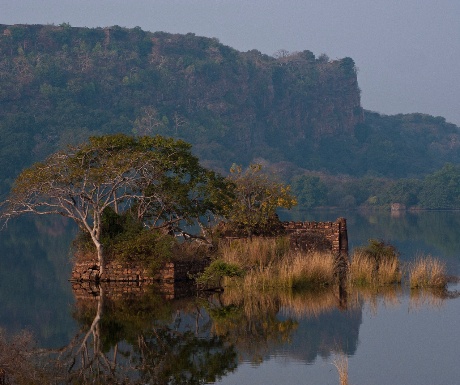 Sadly, we were not to see a tiger on our visit but its a numbers game, and the more safari excursions you book, the higher your chances of seeing a tiger. We did see a few leopards though, which we understand are typically even harder to spot, as well as nilgai and the rhesus macaque. After much effort to find the elusive big cat, we found a clearing, where in typical Aman style, we were treated to a picnic in the middle of Ranthambore National Park with hot tea and coffee and cakes, before returning to the campsite, where, of course, our batman Satish was waiting for us with a refreshing drink and a cold towel.
Sadly, we were not to see a tiger on our visit but its a numbers game, and the more safari excursions you book, the higher your chances of seeing a tiger. We did see a few leopards though, which we understand are typically even harder to spot, as well as nilgai and the rhesus macaque. After much effort to find the elusive big cat, we found a clearing, where in typical Aman style, we were treated to a picnic in the middle of Ranthambore National Park with hot tea and coffee and cakes, before returning to the campsite, where, of course, our batman Satish was waiting for us with a refreshing drink and a cold towel.
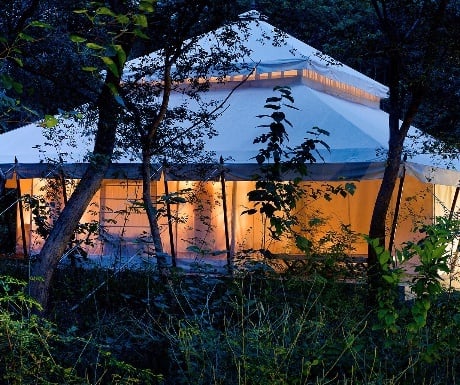 The afternoon was spent lazing and cooling at the camps swimming pool. Drawing from local architecture, the pool is fashioned after a baori, or stepwell wells or ponds that feature a descending set of steps, and are found throughout Rajasthan. Within a minute of finding myself at the pool, an alert attendant came by to set-up the sun-lounger and offered a selection of refreshing drinks and water. Come dusk, the camp takes on a true camp-like atmosphere, where the stone-enclosed elevated patio near the main section of tents, which house the library, spa, restaurant, lounge and boutique, is turned into a cozy camp-side fire in the cool night, where local musicians enchanted us with their folk songs while we enjoyed pre-dinner drinks.
The afternoon was spent lazing and cooling at the camps swimming pool. Drawing from local architecture, the pool is fashioned after a baori, or stepwell wells or ponds that feature a descending set of steps, and are found throughout Rajasthan. Within a minute of finding myself at the pool, an alert attendant came by to set-up the sun-lounger and offered a selection of refreshing drinks and water. Come dusk, the camp takes on a true camp-like atmosphere, where the stone-enclosed elevated patio near the main section of tents, which house the library, spa, restaurant, lounge and boutique, is turned into a cozy camp-side fire in the cool night, where local musicians enchanted us with their folk songs while we enjoyed pre-dinner drinks.
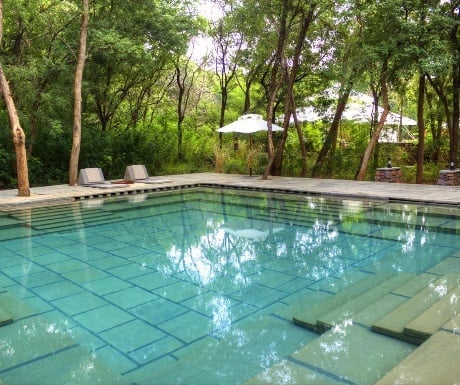 While the main set of tents house the restaurant space, guests are also often treated to a special dining experience (set up by the batman) on the outskirts of the camps property, with settings that mix tradition (using earthen tandoors, iron, copper pots and homemade clay ovens,) and modern comforts (tables and seats) in a truly spectacular setting in the midst of the jungle beneath the stars. The camps large herb and vegetable gardens produce most of the stock used for food, and a mix of local Indian fare and Western is available for breakfast, lunch and dinner, including the Rajasthani specialty of laal maas, a tender lamb curry cooked in yoghurt and chillies, that was the highlight of our private dinner.
While the main set of tents house the restaurant space, guests are also often treated to a special dining experience (set up by the batman) on the outskirts of the camps property, with settings that mix tradition (using earthen tandoors, iron, copper pots and homemade clay ovens,) and modern comforts (tables and seats) in a truly spectacular setting in the midst of the jungle beneath the stars. The camps large herb and vegetable gardens produce most of the stock used for food, and a mix of local Indian fare and Western is available for breakfast, lunch and dinner, including the Rajasthani specialty of laal maas, a tender lamb curry cooked in yoghurt and chillies, that was the highlight of our private dinner.
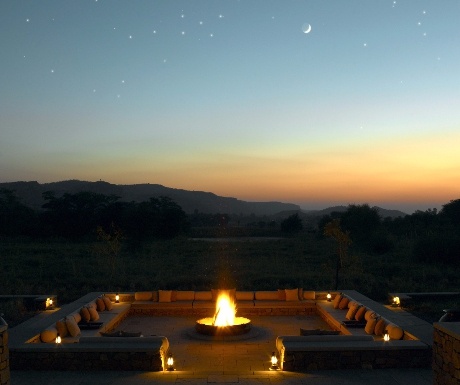 On our final afternoon, we ventured back to Ranthambore National Park, but this time not for a chance to spot a tiger. Ranthambore Fort, a UNESCO World Heritage Site, sits within the confines of Ranthambore National Park. Although the exact history of the fort is yet to be established (the fort holds many myths and legends), it is known that it was built by a Chauhan Rajput ruler sometime between 944-1110 CE. Our guide led us through the several gates and layers of the fort, relaying the many myths and legends and a bit of history, leaving us to be the judge.
On our final afternoon, we ventured back to Ranthambore National Park, but this time not for a chance to spot a tiger. Ranthambore Fort, a UNESCO World Heritage Site, sits within the confines of Ranthambore National Park. Although the exact history of the fort is yet to be established (the fort holds many myths and legends), it is known that it was built by a Chauhan Rajput ruler sometime between 944-1110 CE. Our guide led us through the several gates and layers of the fort, relaying the many myths and legends and a bit of history, leaving us to be the judge.
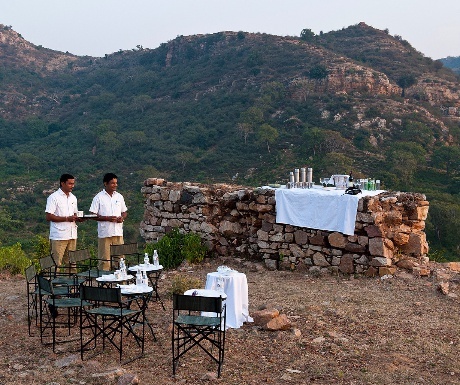 Walking back to the entrance of the fort exhausted from the elevated climbs and looking forward to afternoon tea at the camp, our guide purposely led us astray on one turn, much to our dismay. The astray route led us to dark chambers and narrow stairwells, which we were reluctant to climb, but did so at the insistence of our guide. After huffing and puffing our way to the top of the stairs, it immediately became clear why our guide insisted on the extra effort at a large clearing of the fort with panoramic views over Ranthambore Fort, stood our batman Satish, holding a picnic basket replete with cakes and biscuits and a flask with hot tea, and a cup of warm milk on the side as my partner had once requested on the very first day, a preference well remembered. With Satishs thoughtful surprise and exemplary service, we enjoyed afternoon tea at a timely manner at the fort, with stunning views overlooking Ranthambore.
Walking back to the entrance of the fort exhausted from the elevated climbs and looking forward to afternoon tea at the camp, our guide purposely led us astray on one turn, much to our dismay. The astray route led us to dark chambers and narrow stairwells, which we were reluctant to climb, but did so at the insistence of our guide. After huffing and puffing our way to the top of the stairs, it immediately became clear why our guide insisted on the extra effort at a large clearing of the fort with panoramic views over Ranthambore Fort, stood our batman Satish, holding a picnic basket replete with cakes and biscuits and a flask with hot tea, and a cup of warm milk on the side as my partner had once requested on the very first day, a preference well remembered. With Satishs thoughtful surprise and exemplary service, we enjoyed afternoon tea at a timely manner at the fort, with stunning views overlooking Ranthambore.
 Checking out the next day after a hearty breakfast was difficult, but it was onward to our next Aman in India, Amanbagh. Read our review of Amanbagh here.
For travelers to India looking to extend their stay or experience something beyond Rajasthans series of forts, palaces and fort-/palace-hotels, Amans wildlife tented camp and retreat is the perfect alternative or addition to the traditional Rajasthani itinerary.
Disclosure: Our stay was courtesy of Aman-i-Khas.
Checking out the next day after a hearty breakfast was difficult, but it was onward to our next Aman in India, Amanbagh. Read our review of Amanbagh here.
For travelers to India looking to extend their stay or experience something beyond Rajasthans series of forts, palaces and fort-/palace-hotels, Amans wildlife tented camp and retreat is the perfect alternative or addition to the traditional Rajasthani itinerary.
Disclosure: Our stay was courtesy of Aman-i-Khas.Did you enjoy this article?
Receive similar content direct to your inbox.


I feel like I’ll be 10x closer to nature if I get to travel there. Would I need to get any shots for mosquitoes before travelling?
Awesome photos by the way! Great post as usual!
@John – thanks for your kind reply. Any precautions against malaria are always recommended, but Aman has generally done a fantastic job as far as mosquitos are concerned. Having said that, it is VERY foresty in the area so there WILL be insects/mosquitos of some kind.